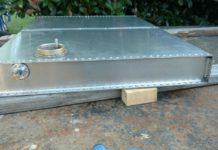There has been some question among our builders as to the proper horizontal stabilizer position relative to water line 100. Through our investigations we found many factors that affect the nose trim position in flight. Some of the more significant ones are angle of decalage, defined as the relationship between wing incidence and the horizontal tail incidence, aircraft weight and balance, airfoil contour, and aileron and flap settings.

Field reports show that most of the Glasair IIIs reporting problems do not have enough forward trim at high speed or fly with their elevator counterweights slightly high at that speed in level flight. The first builder-built G-III flying found that his aircraft flies with his counterweights too low at high speed. Our prototype’s counterweights are about 1/8″ high at high speed with its water line perfectly level.
Measurements taken from three different G-IIIs gave us so many variables and scattered data that inconclusive results could be made. A recent problem discovered with our trim system cable drum not actually able to rotate to its stops because of interference with the drum thread and the housing radius, addressed in Service Bulletin 67, may cause the inadequate forward trim in some cases.
Flight testing has shown a significant effect, for at least one aircraft, on nose attitude by simply adjusting the flaps up or down as needed. If adjusting the flap stops and flap actuator rods out to move the flaps down, less forward trim would be required. This has not been verified on other Glasairs yet, but we felt it was worth mentioning. If anyone else has done this, please let us know so we may share your information with other builders. The ailerons can also be adjusted in the same manner to reduce the total amount of control surface change.
Another builder was successful by laminating a trim tab, similar to the one in the rudder, into the trailing edge of his elevator.
If we determine a change in horizontal stabilizer angle of incidence is necessary it would most likely be a leading edge up position of only 1/4″ to 1/2″ relative to water line 100. In the meantime we feel that the present position of 0″ to water line is close enough to the optimum position to not cause a change to our construction manuals until more conclusive information is obtained.
Also note that 1/2° or 1/4° is a very small change and hard to measure accurately.



